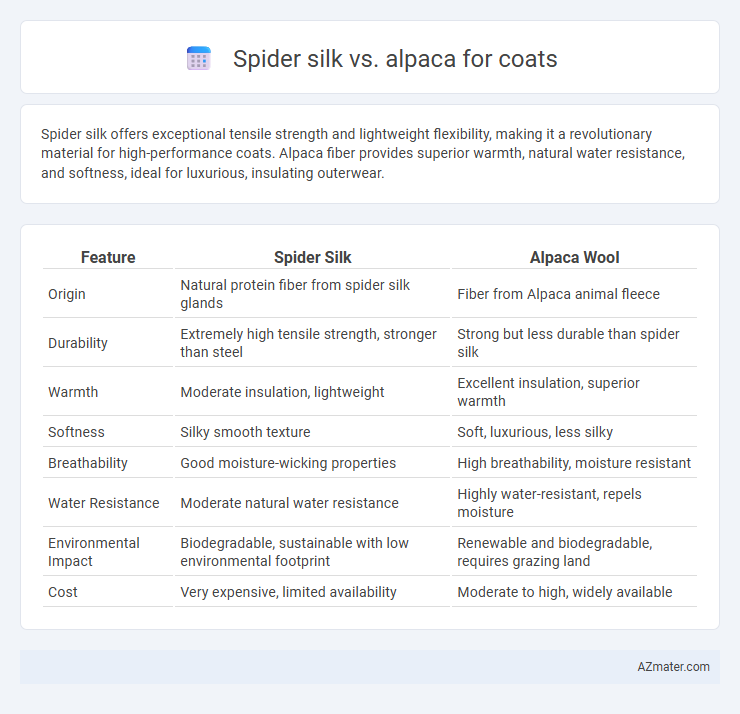Spider silk offers exceptional tensile strength and lightweight flexibility, making it a revolutionary material for high-performance coats. Alpaca fiber provides superior warmth, natural water resistance, and softness, ideal for luxurious, insulating outerwear.
Table of Comparison
| Feature | Spider Silk | Alpaca Wool |
|---|---|---|
| Origin | Natural protein fiber from spider silk glands | Fiber from Alpaca animal fleece |
| Durability | Extremely high tensile strength, stronger than steel | Strong but less durable than spider silk |
| Warmth | Moderate insulation, lightweight | Excellent insulation, superior warmth |
| Softness | Silky smooth texture | Soft, luxurious, less silky |
| Breathability | Good moisture-wicking properties | High breathability, moisture resistant |
| Water Resistance | Moderate natural water resistance | Highly water-resistant, repels moisture |
| Environmental Impact | Biodegradable, sustainable with low environmental footprint | Renewable and biodegradable, requires grazing land |
| Cost | Very expensive, limited availability | Moderate to high, widely available |
Introduction: Comparing Spider Silk and Alpaca for Coats
Spider silk offers exceptional tensile strength and lightweight properties, making it a revolutionary material for durable coats. Alpaca wool, known for its superior insulation, softness, and hypoallergenic qualities, excels in warmth and comfort. Evaluating spider silk against alpaca highlights the balance between innovative strength and natural thermal performance in coat materials.
Material Origins: How Spider Silk and Alpaca Fibers are Sourced
Spider silk is produced by spiders through specialized silk glands, harvested in limited quantities either directly from webs or via genetically engineered organisms for scalable use. Alpaca fibers come from the shearing of domesticated alpacas native to South America, primarily Peru, where the animal is gently shorn annually to collect soft, insulating fleece. Both materials emphasize sustainable sourcing practices, with spider silk relying on bioengineering advancements and alpaca fibers driven by traditional pastoralism.
Strength and Durability: Which Fiber Lasts Longer?
Spider silk outperforms alpaca fiber in terms of strength, boasting tensile strength comparable to steel while remaining lightweight and flexible. Alpaca fiber offers good durability with resistance to pilling and excellent insulation properties, but it is more prone to wear over time compared to spider silk. For a coat aimed at maximum longevity and resilience, spider silk fibers provide superior endurance under stress and environmental factors.
Warmth and Insulation: Thermal Properties Compared
Spider silk exhibits exceptional thermal regulation due to its fine, lightweight fibers with high tensile strength and moisture-wicking capabilities, making it ideal for insulation in coats. Alpaca wool provides superior warmth through its hollow fiber structure, which traps heat efficiently while remaining lightweight and breathable. Compared to spider silk, alpaca offers greater natural insulation, making it more effective for maintaining body heat in cold environments.
Softness and Comfort: The Feel of Spider Silk vs. Alpaca
Spider silk fibers offer an exceptional softness and lightweight texture, providing a smooth, almost breathable feel that enhances comfort in coats. Alpaca wool, known for its natural warmth and plush softness, delivers a cozy, insulating comfort ideal for cold climates without the itchiness typical of some wools. The comparison highlights spider silk's sleek, delicate touch versus alpaca's cushioned, warm embrace, making both materials excellent yet distinct choices for luxurious outerwear.
Sustainability and Environmental Impact
Spider silk offers exceptional sustainability due to its biodegradability and low-energy production processes, minimizing environmental impact compared to conventional fibers. Alpaca wool is a renewable resource harvested from alpacas, which have a gentle grazing habit that preserves soil health and promotes biodiversity. Both materials provide eco-friendly alternatives to synthetic fibers, but spider silk's potential for lab-grown production further reduces resource consumption and greenhouse gas emissions.
Hypoallergenic Properties: Sensitive Skin Considerations
Spider silk features remarkable hypoallergenic properties, making it an excellent choice for sensitive skin due to its natural protein structure that resists allergens and irritants. Alpaca fiber is also hypoallergenic, containing no lanolin, which reduces the risk of skin irritation, but may still cause sensitivity in individuals allergic to animal proteins. Both materials offer breathable, moisture-wicking qualities that further enhance comfort for those with delicate skin conditions.
Stylish Appeal: Aesthetic Differences in Coats
Spider silk coats offer a futuristic, sleek aesthetic with a unique, glossy sheen that enhances modern, avant-garde designs, setting them apart in high-fashion circles. Alpaca coats showcase natural warmth and softness with a matte, textured finish, providing a classic, luxurious look steeped in heritage and understated elegance. The choice between spider silk's innovative smoothness and alpaca's cozy, tactile appeal defines distinct style statements in outerwear.
Cost and Availability of Spider Silk and Alpaca
Spider silk remains prohibitively expensive due to complex production methods and limited scalability, making it rare and less accessible for coat manufacturing. Alpaca fibers, sourced from abundant South American herds, offer a cost-effective alternative with widespread availability in global textile markets. Cost efficiency and supply stability favor alpaca over spider silk for practical and affordable coat production.
Conclusion: Choosing the Best Fiber for Your Next Coat
Spider silk offers unparalleled strength, natural elasticity, and lightweight warmth, making it an innovative choice for luxury coats requiring durability and comfort. Alpaca fiber provides exceptional insulation, softness, and hypoallergenic properties, ideal for warmth and cozy wear in colder climates. When choosing the best fiber for your next coat, consider spider silk for cutting-edge performance and alpaca for traditional warmth and softness.

Infographic: Spider silk vs Alpaca for Coat
 azmater.com
azmater.com